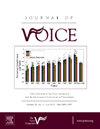Intonation Parameters in Gender Diverse People
IF 2.5
4区 医学
Q1 AUDIOLOGY & SPEECH-LANGUAGE PATHOLOGY
引用次数: 0
Abstract
Objectives/hypothesis
Although intonation is often addressed in speech training for gender diverse individuals, the relationship between intonation and femininity/masculinity ratings remains unclear. The aim of this study was to examine differences in intonation parameters in gender diverse individuals. Moreover, the relationship between acoustic intonation parameters and femininity/masculinity ratings was investigated.
Methods
Speech samples of semistructured speech were elicited from cisgender (cis) (107 ciswomen, 104 cis men), transgender (trans) (19 trans women, 10 trans men), and non-binary (n = 11) individuals using a prosody protocol. An objective acoustic analysis was performed to compare intonation parameters (upward/downward/flat intonation shift, general and final intonation shift, general fundamental frequency range, fundamental frequency variation index) between groups. In addition, a listening experiment was conducted, consisting of a cis and gender diverse listening panel (n = 41). The listeners were asked to rate the femininity/masculinity of speech samples (n = 57) using a visual analogue scale. Correlational analyses were used to examine the relationship between intonation parameters and femininity/masculinity ratings.
Results
Similarity was found in the intonation parameters of participants with a similar gender identity. In non-binary speakers, no significant differences in acoustic intonation parameters were found between these speakers and the cisgender speakers. In addition, no significant correlations were found between the acoustic intonation parameters and the femininity/masculinity ratings in the groups with cis men, cis women, and non-binary participants. However, moderate to strong significant correlations were found between acoustic intonation parameters and femininity/masculinity ratings in the trans participants.
Conclusions
Intonation is a “speech marker” that distinguishes between groups with a different gender identity. No relationship was observed between intonation and femininity/masculinity ratings for cisgender and non-binary speakers. However, the significant relationship between these parameters for transgender participants (trans men and trans women) provides evidence for intonation exercises in gender affirming voice, speech, and communication training, and therefore contribute to evidence-based intonation training in transgender persons.
不同性别人群的语调参数
目标/假设:虽然在针对不同性别者的语音训练中经常会涉及语调问题,但语调与女性/男性气质评分之间的关系仍不清楚。本研究的目的是考察不同性别的人在语调参数上的差异。此外,还研究了声学语调参数与女性/男性气质评分之间的关系:方法:使用拟声协议从顺性(cis)(107 名顺性女性,104 名顺性男性)、变性(trans)(19 名变性女性,10 名变性男性)和非二元(n = 11)个体中提取半结构化语音样本。我们进行了客观声学分析,以比较各组之间的音调参数(上行/下行/平缓音调偏移、一般和最终音调偏移、一般基频范围、基频变化指数)。此外,还进行了一项听力实验,由顺性和性别不同的听力小组(n = 41)组成。实验要求听者使用视觉类比量表对语音样本(n = 57)的女性/男性特征进行评分。相关分析用于研究语调参数与女性/男性气质评分之间的关系:结果发现,具有相似性别认同的参与者的语调参数具有相似性。在非二元扬声器中,这些扬声器与顺性别扬声器之间的声调参数没有明显差异。此外,在有顺性别男性、顺性别女性和非二元性参与者的小组中,也没有发现声调参数与女性化/男性化评分之间有明显的相关性。然而,在变性参与者中,声调参数与女性/男性特质评分之间存在中度到高度的相关性:结论:语调是区分不同性别身份群体的 "语言标记"。在顺性和非二元说话者中,没有观察到语调与女性/男性特质评级之间的关系。然而,变性参与者(变性男性和变性女性)的这些参数之间的重要关系为在性别肯定语音、演讲和交流培训中进行语调练习提供了证据,因此有助于对变性者进行基于证据的语调培训。
本文章由计算机程序翻译,如有差异,请以英文原文为准。
求助全文
约1分钟内获得全文
求助全文
来源期刊

Journal of Voice
医学-耳鼻喉科学
CiteScore
4.00
自引率
13.60%
发文量
395
审稿时长
59 days
期刊介绍:
The Journal of Voice is widely regarded as the world''s premiere journal for voice medicine and research. This peer-reviewed publication is listed in Index Medicus and is indexed by the Institute for Scientific Information. The journal contains articles written by experts throughout the world on all topics in voice sciences, voice medicine and surgery, and speech-language pathologists'' management of voice-related problems. The journal includes clinical articles, clinical research, and laboratory research. Members of the Foundation receive the journal as a benefit of membership.
 求助内容:
求助内容: 应助结果提醒方式:
应助结果提醒方式:


